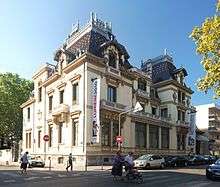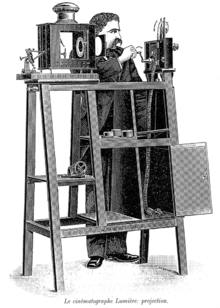Cinematograph
A cinematograph is a motion picture film camera, which — in combination with different parts — also serves as a film projector and printer. It was developed in the 1890s in Lyon by Auguste and Louis Lumière.[notes 1]

History
The device was invented and patented as the "Cinématographe Léon Bouly" by French inventor Léon Bouly on February 12, 1892. Bouly coined the term "cinematograph," from the Greek for "writing in movement."[1] Due to a lack of money, Bouly could not develop his ideas properly and maintain his patent fees, so he sold his rights to the device and name to the Lumière brothers.[2] In 1895, they applied the name to a device that was mostly their own invention.

The Lumière brothers made their first film, Workers Leaving the Lumière Factory (Sortie de l'usine Lumière de Lyon), that same year. The first commercial, public screening of cinematographic films happened on 28 December 1895 at Salon Indien du Grand Café in Paris and was organised by the Lumière brothers.[3] This history-making presentation featured ten short films, including their first film, Workers Leaving the Lumiere Factory.[3] Each of these early films is 17 meters long (approximately 56 feet), which, when hand cranked through a projector, runs approximately 50 seconds.
The Cinématographe was also exhibited at the Paris Exposition of 1900. At the Exposition, films made by the Lumière Brothers were projected onto a large screen measuring 16 by 21 meters (approximately 52.5 x 69 feet).[4]
Several versions of cinématographes were developed, including ones by the inventor Robert Royou Beard (1856-1932),[5] the electrical engineer Cecil Wray (1866-1944),[6] the optician Alfred Wrench (?-?),[7] Georges Demenÿ and, of course, the Lumière brothers.[8]
Invention


Louis Lumière and his brother Auguste worked together to create a motion-picture camera superior to Thomas Edison's kinetograph, which did not have a projector. The Lumières endeavored to correct the flaws they perceived in the kinetograph and the kinetoscope, to develop a machine with both sharper images and better illumination. The Cinématographe weighed only 16 lbs., which allowed for ease of transportation and placement. As well, the Cinématographe was manually operated by a hand-crank, as opposed to Edison's electrically powered camera, which was not readily portable. Furthermore, while only one person at a time could use Edison's kinetoscope for viewing—through an eyepiece, peep show style—the Cinématographe could project an image onto a screen so a large audience of people could view images simultaneously.[9]
The Cinématographe produced a sharper projected image than had been seen before due to its design, in which a kind of fork held frames behind the lens in place using the perforations in the sides of the film strip.
In 1897, the Lumières further added to their invention by using a glass flask of water as the condenser to concentrate the light onto the film frame and to absorb heat. The flask also acted as a safety feature, as the light would no longer focus on the flammable film if the glass were to break due to overheating or accident.[4]
Popularity
After the success of the Lumières's initial public screening in 1895, the Cinématographe became a popular attraction for people all over the world. The Lumière brothers took their machine to China and India[9] and it was enjoyed by people of all classes and social standings. The Cinématographe was used to show films in nickelodeons, where even the poorest classes could pay the entry fee. It was exhibited at fairs and used as entertainment in vaudeville houses in both Europe and the United States. While vaudeville is typically associated with the working and middle classes, the machine also found its way into more sophisticated venues, where it appealed to the artistic tastes of high society.[1]
See also
- Bioscop
- Biograph
- Electrotachyscope
- Film
- Image
- Kinetoscope
- List of film formats
- Panoptikon
- Pleograph
- Praxinoscope
- Vitascope
- Zoopraxiscope
Notes
- This was not the first 'moving picture' device. Louis Le Prince had built early devices in 1886. His 1888 film Roundhay Garden Scene still survives.
References
- Abel, Richard. Encyclopedia of Early Cinema. 1st ed. London: Routledge, 2004.
- Cinéma des premiers temps: nouvelles contributions françaises par Michel Marié, Thierry Lefebvre, in collection Théorème (1996)
- Louis Lumière, The Lumière Cinematograph. In:Fielding, Raymond (1979). A technological history of motion pictures and television: an anthology from the pages of the Journal of the Society of Motion Picture and Television Engineers. University of California Press. pp. 49–51. ISBN 0-520-03981-5.
- Cinematograph, Louis Lumière. “1936 the Lumière Cinematograph.” SMPTE Journal 105, no. 10 (October 1, 1996): 608–611.
- Who's Who of Victorian Cinema: Biography of Beard
- Who's Who of Victorian Cinema: Biography of Wray
- Who's Who of Victorian Cinema: Biography of Wrench
- "Machines". Who's Who of Victorian Cinema. British Film Institute.
- Gomery, Professor Douglas, and Clara Pafort-Overduin. Movie History: A Survey. Taylor & Francis, 2011.
External links
| Wikimedia Commons has media related to Cinematograph. |
- Adventures in Cybersound
- . Encyclopedia Americana. 1920.
- . Encyclopædia Britannica. 6 (11th ed.). 1911. pp. 374–375.
